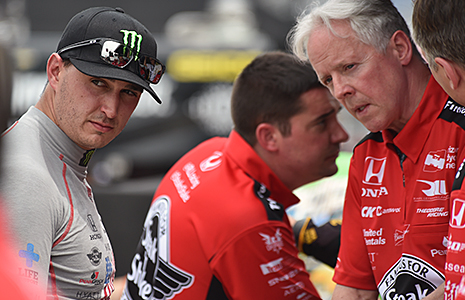Bourdais, Rahal showing one-car teams can succeed
JUN 17, 2016
Conventional wisdom dictates that having a teammate in racing helps both drivers go faster.
The theory is that each driver can bounce ideas off the other and both benefit from the interaction to find more speed in the car, while drivers in one-car teams find themselves on their back foot trying to figure things out alone.
Apparently, somebody forgot to mention this to Sebastien Bourdais and Graham Rahal, who have both excelled in one-car teams.
Earlier this month, No. 11 KVSH Racing Chevrolet driver Bourdais (pictured above with team co-owner Jimmy Vasser) became one of six different drivers to win a Verizon IndyCar Series race this year when he took the checkered flag in Race 1 of the Chevrolet Dual in Detroit presented by Quicken Loans.
“I don't think you can always say that multi-car teams makes (better) performance,” Bourdais said after earning career win No. 35, tying him for sixth on the all-time Indy car list with Bobby Unser.
“It comes from the base of the car being really switched on and certain things being done the right way when the team has done its homework and has enough money to make it happen,” Bourdais added. “That's No. 1. I'd definitely take a proper, smart race engineer that I can relate to very quickly and understand each other very well rather than a teammate.”
Bourdais feels that the biggest limitation on his team is budget, which affects the number of “smart people” it can hire, what tests it can do and how many side projects it can undertake.
For more proof that a teammate isn't necessary to success, Bourdais pointed to the results of No. 15 Rahal Letterman Lanigan Racing Honda driver Graham Rahal over the past couple seasons in a one-car team that competed for the 2015 Verizon IndyCar Series championship to the season finale.
“They have a very well-sorted-out team and some consistency (in personnel) over the winters and they do very well with only one car,” Bourdais said.
Ironically, Bourdais and Rahal were once teammates – with Newman/Haas Racing in 2007 when Rahal was a Champ Car rookie and Bourdais was on his way to a record fourth straight Indy car championship. Each has had part-time teammates in 2016 – RLL adding Spencer Pigot for three races and KV taking on Matt Brabham and Stefan Wilson in May – but neither situation provided the consistent give-and-take seen with multi-car teams in the series.
 For his part, Rahal (pictured at left with engineer Eddie Jones) knows his outfit is focused on the job at hand, but feels sometimes it might be nice to have another driver in the team corner.
For his part, Rahal (pictured at left with engineer Eddie Jones) knows his outfit is focused on the job at hand, but feels sometimes it might be nice to have another driver in the team corner.
“Where it got really difficult for us was Phoenix,” Rahal said, referring to the Desert Diamond West Valley Phoenix Grand Prix on the Phoenix International Raceway’s mile oval in April. “We came out of the box and, my gosh, that thing was loose, really bad, but how do we recover? You have no time, turnaround from one session to the next, no data to learn from.
“If you're Andretti (Autosport) with Honda, you've got four cars to learn from, so somebody can be trying one (aero kit) pod and another guy can try different speedway trim, this, that. That's where it really hurt us, honestly.”
Hurt is a relative term because Rahal finished the race in fifth and was the top Honda-powered driver.
Like Bourdais, Rahal understands that it comes down to having the right people in the squad to get the job done, teammate or no teammate.
“I would put my team up against any team out here as far as the quality of personnel that we have, the mindset,” Rahal said.
“We have an excellent group of people and I don't think that they get distracted. My guys are awesome. I mean, they really do make a heck of a difference in this whole deal.”
While he's comfortable being the sole KVSH driver, Bourdais did say that at times he has found himself in situations where a teammate did help make things happen.
For example, he and his Newman/Haas stablemate from 2003-06, Bruno Junqueira, often pushed each other in the right direction. When one found something that was significantly faster on one car, it was a good bet that it was also going to be quicker on the other car. But things don't always work that way, Bourdais insisted.
“It takes a very special set of teammates for them to feed off of each other without the relationship becoming explosive and negative,” he said.
“A good teammate is always a fast teammate, but if he requires something very different from the car, it's just a pain in the butt because it doesn't help you make your car quicker and there's very little you can learn from that.”






















